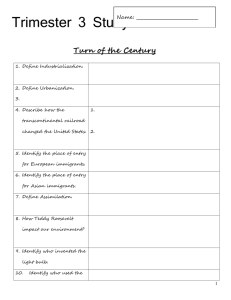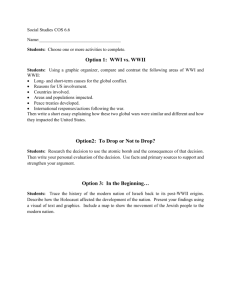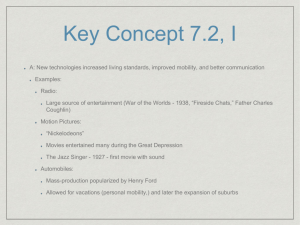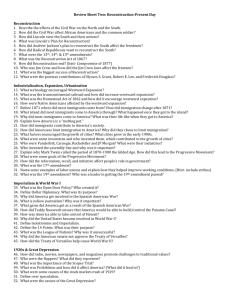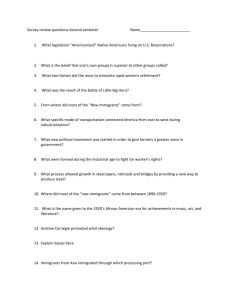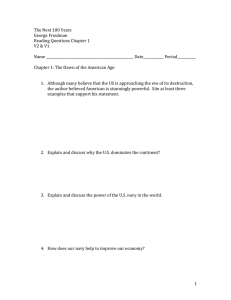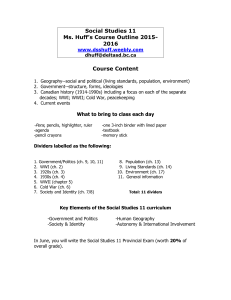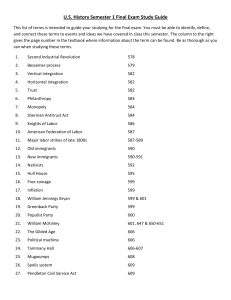UNIONDALE SCHOOL DISTRICT SOCIAL STUDIES GRADE 8 CALENDAR OF LESSONS
advertisement
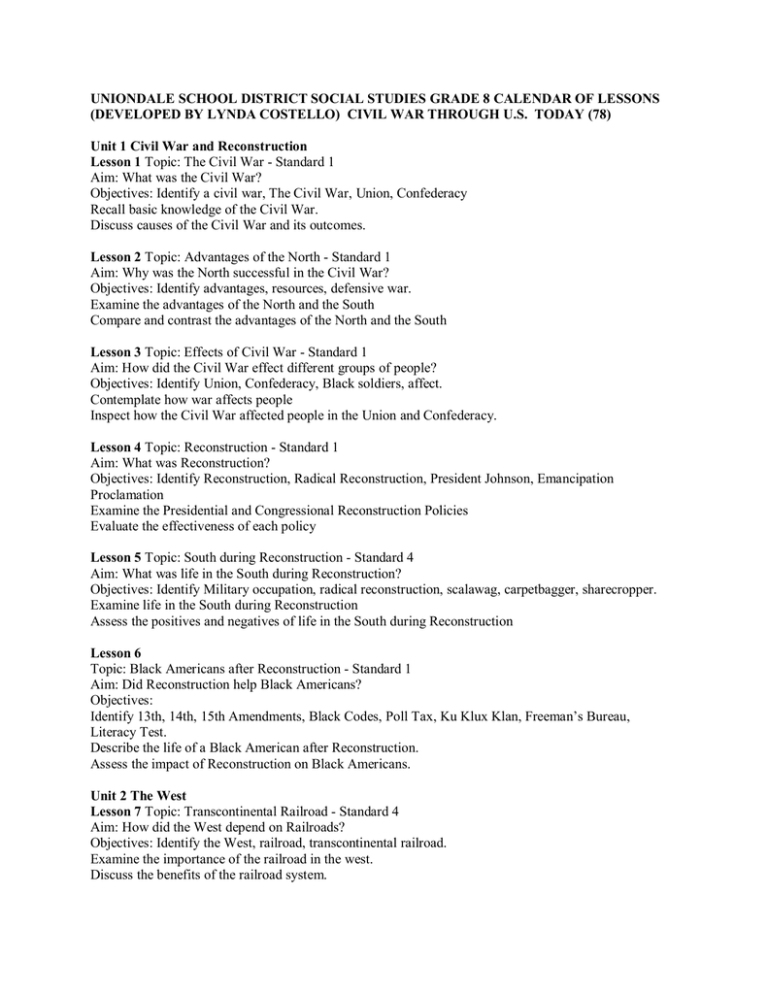
UNIONDALE SCHOOL DISTRICT SOCIAL STUDIES GRADE 8 CALENDAR OF LESSONS (DEVELOPED BY LYNDA COSTELLO) CIVIL WAR THROUGH U.S. TODAY (78) Unit 1 Civil War and Reconstruction Lesson 1 Topic: The Civil War - Standard 1 Aim: What was the Civil War? Objectives: Identify a civil war, The Civil War, Union, Confederacy Recall basic knowledge of the Civil War. Discuss causes of the Civil War and its outcomes. Lesson 2 Topic: Advantages of the North - Standard 1 Aim: Why was the North successful in the Civil War? Objectives: Identify advantages, resources, defensive war. Examine the advantages of the North and the South Compare and contrast the advantages of the North and the South Lesson 3 Topic: Effects of Civil War - Standard 1 Aim: How did the Civil War effect different groups of people? Objectives: Identify Union, Confederacy, Black soldiers, affect. Contemplate how war affects people Inspect how the Civil War affected people in the Union and Confederacy. Lesson 4 Topic: Reconstruction - Standard 1 Aim: What was Reconstruction? Objectives: Identify Reconstruction, Radical Reconstruction, President Johnson, Emancipation Proclamation Examine the Presidential and Congressional Reconstruction Policies Evaluate the effectiveness of each policy Lesson 5 Topic: South during Reconstruction - Standard 4 Aim: What was life in the South during Reconstruction? Objectives: Identify Military occupation, radical reconstruction, scalawag, carpetbagger, sharecropper. Examine life in the South during Reconstruction Assess the positives and negatives of life in the South during Reconstruction Lesson 6 Topic: Black Americans after Reconstruction - Standard 1 Aim: Did Reconstruction help Black Americans? Objectives: Identify 13th, 14th, 15th Amendments, Black Codes, Poll Tax, Ku Klux Klan, Freeman’s Bureau, Literacy Test. Describe the life of a Black American after Reconstruction. Assess the impact of Reconstruction on Black Americans. Unit 2 The West Lesson 7 Topic: Transcontinental Railroad - Standard 4 Aim: How did the West depend on Railroads? Objectives: Identify the West, railroad, transcontinental railroad. Examine the importance of the railroad in the west. Discuss the benefits of the railroad system. Lesson 8 Topic: Life in the West - Standard 3 Aim: How did the railroads change life in the West? Objectives: Identify Pioneers, mining, cowboys, vaqueros, catalogs, cattle kingdom, Homestead Act, Exodusters. Examine life in the West. Discuss the positives and negatives of living in the West. Lesson 9 Topic: Native Americans in the West - Standard 1 Aim: Did white break their promise to the Native Americans? Objectives: Identify Plains Indians, reservation, Dawes Act. Identify the role of the whites took with Native Americans. Determine the a Native Americans quality of life under white man’s control. Unit 3 INDUSTRIALIZATION Lesson 10 Topic: Industrialization - Standard 4 Aim: What is Industrialization? Objectives: Identify Industrialization, labor force, textiles, inventions Explain the history of industrialization Assess the importance of inventions to industrialization. Lesson 11 Topic: Interchangeable parts - Standard 4 Aim: How were interchangeable parts and important part of industrialization? Objectives: Identify Interchangeable parts, assembly line, mass production, Henry Ford, Bessemer Process. Demonstrate the process of an assembly line. Assess how important mass production is to industrialization. Lesson 12 Topic: Rockefeller - Standard 1 Aim: Was John D. Rockefeller a business pioneer or a “robber baron”? Objectives: Identify Big business, captains of industry, free enterprise, corporations, trusts, monopoly, natural resources, robber baron, Rockefeller, Morgan, Vanderbilt, Carnegie. Examine the life of John D. Rockefeller Assess whether Rockefeller was a pioneer or a robber baron. Lesson 13 Topic: Workers - Standard 4 Aim: Did mass production have an impact on the factory workers? Objectives: Identify Child labor, sweatshops, wages, benefits. Examine conditions in factories. Speculate ways to improve factory conditions. Lesson 14 Topic: Labor Unions - Standard 5 Aim: How responsible were Labor Unions? Objectives: Identify Labor Unions, Knights of Labor, AFL, Haymarket Riot, Samuel Gompers, Mother Jones, Triangle fire. Examine reasons for formation of unions. Assess effectiveness of unions. Lesson 15 Topic: Government reaction - Standard 1 Aim: How did government respond to big business? Objectives: Identify Laizze Faire, regulations, Interstate Commerce Act, Sherman Anti-Trust Act, rebates, pools. Examine ways in which government responded to big business. Judge if this reaction was appropriate. Lesson 16 Topic: Farmers - Standard 4 Aim: In what ways did industrialization affect farmers? Objectives: Identify the Grange, Populist party. Examine how industrialization affected farmers. Discuss the positives and negatives of industrialization in the west. Unit 4 IMMIGRATION Lesson 17 Topic: Causes of immigration - Standard 2 Aim: What motivated immigrants to come to the U.S. ? Objectives: Identify Immigration, immigrants, persecution, old immigrants, new immigrants. Examine reasons for immigration. Analyze reasons for immigration. Lesson 18 Topic: Immigrants travel - Standard 1 Aim: What problems did immigrants fare coming to America? Objectives: Identify Ellis Island, Statue of Liberty Examine requirements immigrants needed to enter U.S. and their transportation to the U.S. Evaluate impact of their experiences Lesson 19 Topic: Treatment of Immigrants - Standard 1 Aim: Were Americans justified in their treatment of immigrants? Objectives: Identify Ethnic, sterotype, open immigration, nativism, quota system, old immigrants, new immigrants. Examine how Americans treated immigrants Determine reasons for U.S. immigration policy from 1880-1930. Lesson 20 Topic: Treatment of Immigrants - Standard 1 Aim: Is the U.S. a melting pot? Objectives: Identify Melting pot, salad bowl, ghetto assimilation. Examine immigrants’ experience in America. Assess how immigrants assimilated into American culture. Lesson 21 Topic: Effects of Immigration - Standard 4 Aim: Did immigration impact the U.S. positively or negatively? Objectives: Identify Overpopulation, discrimination, segregation. List ways immigration impacted U.S. Assess if immigration had a positive or negative impact on U.S. Unit 5 THE PROGRESSIVE MOVEMENT Lesson 22 Topic: Progressive Movement - Standard 1 Aim: What is the Progressive Movement? Objectives: Identify Progressive movement, laizze faire, social ills, abuses. Examine reasons people wanted a change in American society. Assess if the attempt to change society was warranted. Lesson 23 Topic: Muckrakers - Standard 1 Aim: In which ways did muckrakers deal with America’s social ills? Objectives: Identify Muckrakers, Ida Tarbell, Upton Sinclair, Florence Lucus Sanville, Lincoln Steffens, Jacob Riis. Examine social abuses muckrakers dealt with. Assess how muckrakers dealt with these social abuses. Lesson 24 Topic: Government Response - Standard 5 Aim: Did government’s response to muckrakers solve the social ills of America? Objectives: Identify Interstate Commerce Act, Federal Trade Commission, Civil Service Act, Meat Inspection Act, Pure Food and Drug Act. Describe various government responses to muckrakers. Evaluate if these responses would solve America’s social ills. Lesson 25 Topic: Others in the progressive movement - Standard 1 Aim: How did other reformers in the Progressive movement change America? Objectives: Identify Jane Addams, Hull House, Settlement houses, James Garfield, Spoils system, Carrie Chapman Catt, 19th Amendment, Carrie Nation, Temperance Movement, 18th Amendment. Examine reformers and their causes. Assess how these reformers impacted society. Lesson 26 Topic: Government response - Standard 5 Aim: Did government respond to the Progressive Movement? Objectives: Identify Primary, initiative, referendum, Wisconsin idea, recall, 16th Amendment, 17th Amendment. Examine how government responded to America’s demands. Assess if this response was positive or negative. Lesson 27 Topic: Theodore Roosevelt a Progressive? Aim: Was Theodore Roosevelt a Progressive? Objectives: Identify Theodore Roosevelt, trustbuster, square deal, conversation, Howard Taft. Examine ways in which Roosevelt dealt with corruption in big business and the environment. Assess if Roosevelt’s actions classify him as a Progressive. Unit 6 U.S. BECOMES A WORLD POWER Lesson 28 Topic: Imperialism - Standard 1 Aim: Should the U.S. be an imperialist? Objectives: Identify imperialism, interdependent, sphere of influence, isolationism, resources, natural resources. Examine positives and negatives of imperialism. Assess reasons why U.S. became imperialistic. Lesson 29 Topic: Spanish-American War - Standard 1 Aim: Did the Spanish-American War influence the U.S. to practice imperialism? Objectives: Identify Spanish-American War, yellow journalism, expansionism, Western (American) Hemisphere, battleship Maine, immediate cause, long term causes. Examine the causes and effects of the Spanish-American War. Discuss whether the Spanish-American War developed U.S. imperialism. Lesson 30 Topic: Latin American - Standard 2 Aim: How did the U.S. interact with Latin America? Objectives: Identify Big Stick Policy, Dollar Diplomacy, Roosevelt Corollary, Platt Amendment, Monroe Doctrine, Good Neighbor Policy, Theodore Roosevelt, Latin America. Examine reasons for U.S.’s involvement in Latin America. Assess if this involvement was warranted. Lesson 31 Topic: Panama Canal - Standard 2 Aim: How did the Panama Canal prove U.S. influence in Latin America? Objectives: Identify Panama Canal, malaria, yellow-fever. Examine the importance of the Panama Canal. Discuss how U.S. control of the Panama Canal proved U.S. influence in Latin America. Lesson 32 Topic: Interdependence - Standard 1 Aim: Should the U.S. and other countries become interdependent? Objectives: Identify Interdependent, Open Door Policy, Commodore Perry, Annex. Explain U.S.’s involvement with China. Evaluate if reasons for interdependency with other countries is justified. Lesson 33 Topic: Causes of WWI - Standard 2 Aim: What are the causes of World War I? Objectives: Identify World War (WWI), Europe, long term causes, imperialism, nationalism, alliance system, militarism. Examine the meaning of imperialism, nationalism, alliance system, militarism. Assess how each cause influence WWI occurring. Lesson 34 Topic: WWI Begins - Standard 2 Aim: How did WWI begin? Objectives: Identify Immediate cause, catalyst, Archduke Francis Ferdinand, Triple Entente, Triple Alliance, France, Russia, Italy, England, Serbia, Bulgaria, Ottoman Empire, Allied Powers, Central Powers, Germany. Examine role of Archduke Ferdinand. Discuss alliances that formed. Lesson 35 Topic: U.S. Involvement - Standard 1 Aim: Why did the U.S. get involved in WWI? Objectives: Identify Neutral, Zimmerman Note, U-Boats, Naval blockade, President Woodrow Wilson, unrestricted submarine warfare, Russian Revolution. Describe the events that led the U.S. to enter WWI. Assess the U.S.’s reasons for entering the war. Lesson 36 Topic: U.S. during WWI - Standard 4 Aim: How did WWI affect Americans at home? Objectives: Identify Liberty Bonds, Selective Service Act, propaganda, draft, War Industries Board, Conserve, 4-Minute Men. Examine American’s roles and responsibilities during WWI. Analyze how WWI changed the way Americans lived. Lesson 37 Topic: WWI Weapons - Standard 2 Aim: How did new technology change the way WWI was fought? Objectives: Identify Trench warfare, U-Boats (submarines), tanks, gas, barbed wire, grenades, Zepplins, land mines, flame throwers, machine guns. Describe how each advancement worked. Assess how this new technology changed war. Lesson 38 Topic: WWI ends - Standard 1 Aim: How did the Treaty of Versailles compare with Wilson’s 14 Points? Objectives: Identify Armistice, Treaty of Versailles, Wilson’ 14 points, Self Determination. Examine the Treaty of Versailles and Wilson’s 14 Points. Compare and contrast the Treaty of Versailles and Wilson’s 14 Points. Lesson 39 Topic: Effects of WWI - Standard 2 Aim: How did WWI affect the World? Objectives: Identify Social, political, economical extreme nationalism, League of Nations. Examine the social, political and economic effects of WWI on the world. Speculate how the effects will influence the future of the world. Unit 7 1920’s Lesson 40 Topic: Foreign Affairs in the 1920’s - Standard 1 Aim: What role did the U.S. take in foreign affairs in the 1920’s? Objectives: Identify 1920’s isolationism. Examine role the U.S. took in foreign affairs in the 1920’s. Assess reasons for the U.S. taking this position. Lesson 41 Topic: Economy in the 1920’s - Standard 4 Aim: How did the U.S. economy develop in the 1920’s? Objectives: Identify Gross National Product (GNP), profit, wages, income. Explain the reasons for economic prosperity in the 1920’s. Examine the positive and negative affects of economic prosperity. Lesson 42 Topic: Women - Standard 1 Aim: How did women of the 1920’s behave? Objectives: Identify Flapper, independent, Amilia Earhart. Describe the way women changed in the 1920’s. Assess how American culture permitted this changing behavior. Lesson 43 Topic: Harlem Renaissance - Standard 1 Aim: How did the Harlem Renaissance affect Black - Americans? Objectives: Identify Langston Hughes, rebirth, Harlem Renaissance, culture, KKK. Examine the various events/people of the Harlem Renaissance. Assess how the Harlem Renaissance influenced Black-Americans. Lesson 44 Topic: General Life of the 1920’s - Standard 1 Aim: What was life like in the 1920’s? Objectives: Identify Marathon dancing, fads, cars, quota system. Examine life in the 1920’s. Lesson 45 Topic: Prohibition - Standard 1 Aim: Was prohibition a reaction against the easy living of the 1920’s? Objectives: Identify Prohibition, speakeasy, temperance, bootleggers, 18th Amendment, 21st Amendment. Explain facts of Prohibition. Assess if Prohibition was a reaction against the lifestyle of the 1920’s. Lesson 46 Topic: Red Scare - Standard 1 Aim: Were Sacco and Vanzetti scapegoats for American’s fears? Objectives: Identify Red Scare, Sacco and Vanzetti, scapegoats, anarchists, quota system. Examine how Sacco and Vanzetti were a symbol of the Red Scare. Speculate if Sacco and Vanzetti were scapegoats. Unit 8 THE GREAT DEPRESSION Lesson 47 Topic: Causes of the Great Depression - Standard 4 Aim: What events caused the Great Depression? Objectives: Identify Great Depression, installment buying, bank failures, overproduction, stock market, stock market crash, long term causes, immediate cause. Describe the long term causes of the Great Depression. Assess how the stock market crash propelled the U.S. into the Great Depression. Lesson 48 Topic: Life during the Great Depression - Standard 1 Aim: In which ways did the Great Depression affect Americans? Objectives: Identify Soup kitchen, Hoovervilles, President Hoover. Examine life of Americans during the Great Depression. Speculate how this type of living would affect Americans. Lesson 49 Topic: New Deal - Standard 4,1 Aim: How did FDR’s New Deal Programs fit into his concept of government? Objectives: Identify President Franklin Delano Roosevelt (FDR), New Deal, ABC agencies (Alphabet agencies) Explain FDR’s concept of government and his New Deal Programs. Compare and contrast FDR’s concept of government with the New Deal Programs. Lesson 50 Topic: New Deal Programs - Standard 4 Aim: How did the New Deal Programs help Americans out of the Great Depression? Objectives: Identify TVA, CCC, AAA, FDIVC, FHA, PWA. Examine what each New Deal Program did. Assess the effects of the New Deal Programs on Americans. Lesson 51 Topic: Positives/Negatives of the New Deal - Standard 4 Aim: Was the New Deal a positive program for the U.S.? Objectives: Identify Social Security Act. Examine the positives and negatives of the New Deal Programs. Asses the long term effects of the New Deal Programs. Unit 9 WORLD WAR II Lesson 52 Topic: Causes - Standard 2 Aim: What were the causes of World War II Objectives: Identify World War II (WWII), Dictatorship, Nazis, inflation, isolationism, aggression, reparations, appeasement, rearming, Adolf Hitler, Lebenstraum Examine events in Europe, especially in Germany that led the way for WWII. Assess how these events pushed the world into WWII. Lesson 53 Topic: U.S. Involvement - Standard 1 Aim: What events led the U.S. to enter WWII? Objectives: Identify Cash-carry, Lend-lease, Neutral, Pearl Harbor, Japan Examine ways the U.S. was involved before the bombing of Pearl Harbour. Generate reasons for the U.S. entering WWII as a reaction to the bombing. Lesson 54 Topic: Americans in WWII - Standard Aim: How did Americans feel about entering WWII? Objectives: Identify Industrial production, treachery. Examine how Americans helped in the war effort. Decide if Americans supported the war or not. Lesson 55 Topic: Different Groups - Standard 1 Aim: How did the war affect different groups of people in America? Objectives: Identify zoot suit riots, Executive order 8802, anti-Semitism, Tuskegee Airmen. Examine the treatment of various minority groups in America. Determine if the treatment of these groups was positive or negative. Lesson 56 Topic: Women in WWII - Standard 1 Aim: Were American women a benefit to winning WWII? Objectives: Identify Rosie the Riveter, War industries. Describe the role women took during WWII. Assess how their role benefited the Allies’ victory. Lesson 57 Topic: Internment Camps - Standards 1 Aim: Did internment camps deny Japanese - Americans their basic rights/ Objectives: Identify Japanese-Americans, internment camps/relocation camps, executive order 9066. Examine the Japanese-American’s experience in an internment camp. Compare and contrast the Japanese-American experience in an internment camp with the motivation of the U.S. government instituting the camps. Lesson 58 Topic: Holocaust - Standard 2 Aim: What was the Holocaust? Objectives: Identify Nazis, concentration camps, Adolf Hitler, Judaism, Star of David, Final Solution, anti-Semitism, genocide. Explain Hitler’s “rationale” for the holocaust. Analyze reasons why Germany followed Hitler. Lesson 59 Topic: Concentration Camps - Standard 2 Aim: How did the concentration camps fulfill Hitler’s goal of the final solution? Objectives: Identify Concentration camps, final solution, gas chambers, Aushwitz. Examine the process concentration camp victims would endure. Lesson 60 Topic: Holocaust Responsibility - Standard 2 Aim: Who should be blamed for the Holocaust? Objectives: Identify St. Louis (sailing of ), Nuremberg Trails. Examine role the U.S. and Allies took in not helping final solution victims. Assess if the Nuremberg trials truly penalized all who were responsible. Lesson 61 Topic: Weapons - Standards 1 Aim: How was WWII fought? Objectives: Identify Enigma, amphibious, U-Boat, fire bombing, blitzkrieg, Battle of Britain, Luftwaffe island hopping, Kama Kazi Pilots, D-Day, European War, Pacific War, McArthur, Eisenhower, V-E Day, V-J Day. Examine new technology used in WWII. Assess the importance of this new technology in the allies winning WWII. Lesson 62 Topic: Atomic Bomb - Standard 1 Aim: Was the U.S. right to drop the Atomic Bomb on Japan? Objectives: Identify Harry S. Truman, Manhattan Project, Nagasaki, Hiroshima, Atomic Bomb. Examine the events which led to the U.S. dropping the Atomic Bomb on Japan. Assess whether Truman was justified in dropping the Atomic Bomb. Lesson 63 Topic: Effects of WWII - Standard 2 Aim: Is the United Nations essential for World Peace? Objectives: Identify United Nations. Examine the statistical results of WWII (wounded, killed, property damage, etc.) Theorize what the world would do with conflict without the United Nations. Unit 10 1950’s Lesson 64 Topic: Life in the 1950’s Aim: Was life in the 1950’s a reaction to WWII? Objectives: Identify Baby Boom, Suburbs, leisure time, Levittown, fads. Examine life (recreation, housing, education, family living, etc…) of the 1950’s. Speculate if this lifestyle was a reaction to WWII. Lesson 65 Topic: McCarthyism - Standard 1 Aim: Was McCarthy justified in his actions? Objectives: Identify McCarthyism, Communism, Joseph McCarthy. Explain what McCarthy did to Americans. Assess if McCarthy was justified in oppressing people bases on their beliefs. Lesson 66 Topic: U.S. Foreign Policy – Standard 1 Aim: How did the cold war begin? Objectives: Identify Cold War, Berlin Wall, Berlin Air Life, Soviet Union, Communism, Containment, Marshall Plan, NATO, Dètente, Iron Curtain, Warsaw Pact, Yalta Conference. Describe early events of the Cold War. Evaluate reasons for the Cold War. Lesson 67 Topic: Cold War – Standard 2 Aim: How did the Cold War influence U.S. foreign policy? Objectives: Identify Korean War, China, Bay of Pigs. Examine various events that shaped U.S. foreign policy, John F. Kennedy. Determine if the U.S. foreign policy was a result of the Cold War. Unit 11 1960’s Lesson 68 Topic: Vietnam War - Standard 2 Aim: Should the U.S. have become involved in the Vietnam Conflict? Objectives: Identify Vietnam Conflict, President Lyndon B. Johnson, President Richard M. Nixon, Ho Chi Minh, Vietcong, Vietnam, escalation, Guerrilla War, Domino Theory, Gulf of Tonkin Resolution. Examine causes of the Vietnam Conflict. Assess whether the U.S. had justifiable reasons to enter the conflict. Lesson 69 Topic: Americans’ reaction - Standard 1 Aim: How did Americans react to the Vietnam Conflict? Objectives: Identify Anti-War Movement, Student Protest, Kent State. Describe different ways that people protested the War. Examine how young Americans reacted differently than older Americans. Lesson 70 Topic: Results - Standard 1 Aim: Did the U.S. achieve its goal in Vietnam? Objectives: Identify Fall of Saigon Examine statistical results of the Vietnam Conflict. Determine if the U.S. achieved its goals. Lesson 71 Topic: Civil Rights Movement - Standard 1 Aim: What events laid the foundation for the Civil Rights Movement? Objectives: Identify Plessy vs Ferguson, Segregation, Montgomery Bus Boycott, Brown vs Board of Education, Civil Rights Movement. Examine some major steps leading towards the Civil Rights Movement. Assess how those steps created the foundations for the Civil Rights Movement. Lesson 72 Topic: People - Standard 1 Aim: Who were the people who led the way for the Civil Rights Movement? Objectives: Identify A. Phillip Randolph, Marcus Garvey, Booker T. Washington, W.E.B. Dubois. Examine the goals of each man. Assess how each man’s goals were reflected in the Civil Rights Movement. Lesson 73 Topic: Events - Standard 1 Aim: What events shaped the Civil Rights Movement? Objectives: Identify Voter Registration, Jim Crow Laws, Selma Montgomery, March, Sit-ins. Examine major events which occurred during the Civil Rights Movement. Determine the impact these events would have on the movement. Lesson 74 Topic: Malcolm X, Martin Luther King, Jr. -Standard 1 Aim: Are Malcolm X’s beliefs different from Martin Luther King Jr’s. beliefs? Objectives: Identify Malcolm X, Dr., Martin Luther King, Jr., Civil Disobedience. Examine the beliefs of each man. Compare and contrast both men’s opinions. Lesson 75 Topic: African Americans today - Standard 5 Aim: How does the Civil Rights Movement influence African Americans today? Objectives: Identify Million - Man March. Examine statistical data on African Americans today. Decide if the Civil Rights Movement influenced African Americans today. Lesson 76 Topic: Foreign Policy - Standard 1 Aim: How is the U.S. foreign policy shaped without the threat of communism? Objectives: Identify Post Cold War. Examine U.S. foreign policy after the Cold War. Assess if this policy was helpful to the U.S. Lesson 77 Topic: Domestic Policy - Standard 1 Aim: How did Presidents shape domestic policy. Objectives: Identify Domestic policy, Kennedy’s New Frontier, Johnson’s Great Society, Nixon’s Watergate, Jimmy Carter, Ronald Regan, Bush, Clinton. Examine Kennedy’s, Johnson’s, Nixon’s, Carter, Regan’s, Bush’s, Clinton’s domestic policies. Compare and contrast each president’s policy and its effects on society. Lesson 78 Topic: People - Standard 5 Aim: How were minority groups treated in current times? Objectives: Identify Hispanics, immigration, Cesar Chavez, American Indian Movement, National Organization for Women. Examine how minority groups have been treated in recent times. Decide if the reactions of these groups were justified.
